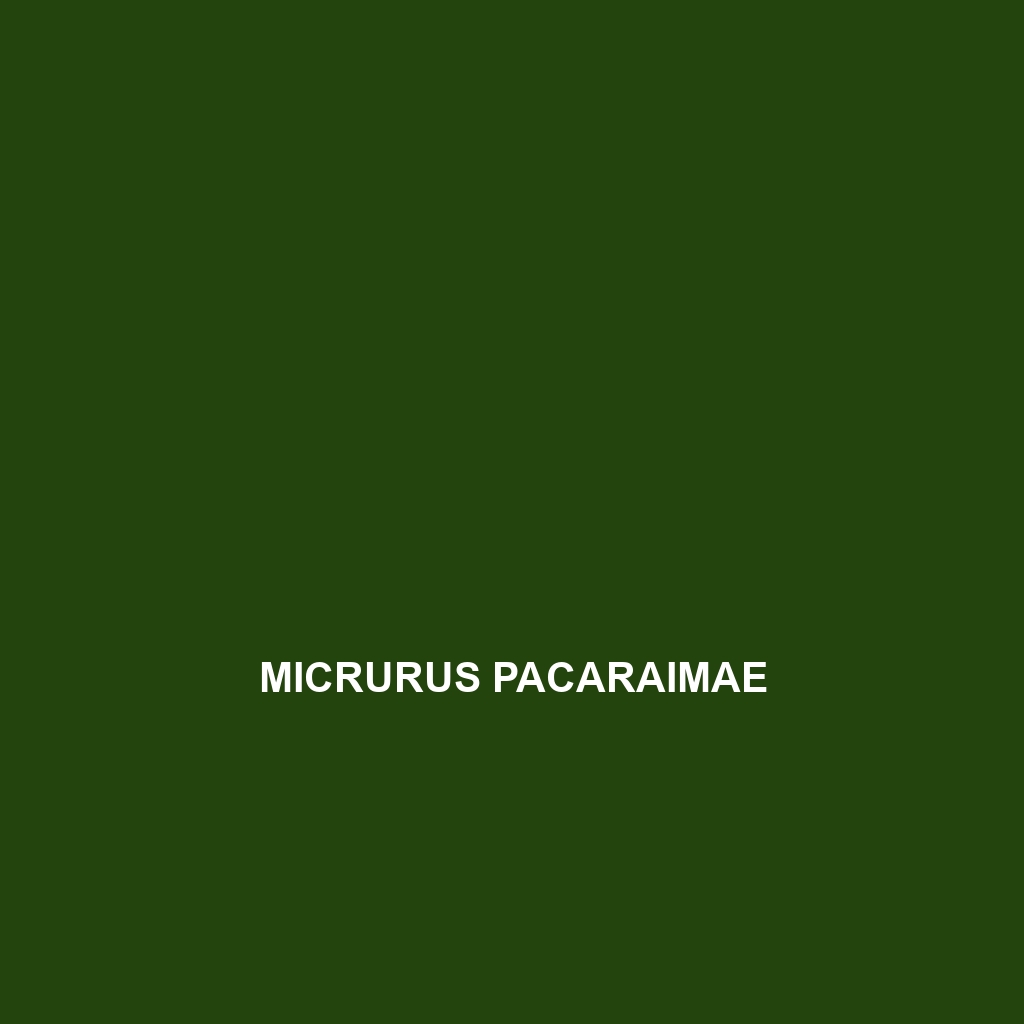Common Name
Micrurus pacaraimae
Scientific Name
Micrurus pacaraimae
Habitat
Micrurus pacaraimae, commonly known as the Pacaraima Coral Snake, is primarily found in the tropical rainforests and savannas of South America. This species inhabits regions such as the Guiana Shield, particularly in Venezuela and Brazil. The climate is humid and warm, featuring lush vegetation and diverse ecosystems. These snakes often prefer areas near streams and water sources, where the moist environment fosters their prey availability. The unique blend of moist, tropical conditions and rich biodiversity plays a critical role in supporting the life cycle of Micrurus pacaraimae.
Physical Characteristics
Measuring between 70 to 120 centimeters in length, Micrurus pacaraimae exhibits a slender and elongated body typical of the elapid family. This snake boasts a striking color pattern that includes black, cream, and red bands, a feature that serves both as a warning to potential predators and an effective form of camouflage within its natural habitat. The bands are arranged in a distinctive order, with black bands separated by narrower alternating colors, making it visually unique. Its smooth scales and elongated head further distinguish it from non-venomous species, making it easily identifiable.
Behavior
Micrurus pacaraimae is primarily a terrestrial snake but is known to exhibit some climbing abilities. It is predominantly nocturnal, which means it is more active during the night, allowing it to evade many daytime predators. This species is solitary, often avoiding contact with others unless it is the breeding season. Interestingly, during mating rituals, males engage in intricate displays of behavior, including scent marking to attract females. These behaviors not only highlight their significance in reproduction but also reveal social interactions throughout their life cycle.
Diet
As a carnivorous predator, Micrurus pacaraimae mainly feeds on small reptiles, amphibians, and invertebrates. Its diet primarily consists of frogs and lizards, which can be plentiful in its rainforest habitat. The snake utilizes its neurotoxic venom to immobilize prey, which is crucial for its survival and hunting strategy. The venom acts quickly, allowing the snake to subdue its meal effectively. This dietary pattern emphasizes its role in controlling the populations of its prey species, thus contributing to the ecological balance in its environment.
Reproduction
The reproductive cycle of Micrurus pacaraimae takes place during the humid and warm seasons, typically around late spring to early summer. Females are oviparous and lay clutches of 6 to 15 eggs, which are then incubated in moist leaf litter or soil. The gestation period varies but is often around 60 to 70 days. After hatching, the juvenile snakes are independent and face numerous challenges in the wild, including predation. Parental care is absent in this species, which often leads to high mortality rates in hatchlings due to environmental factors.
Conservation Status
According to the International Union for Conservation of Nature (IUCN), Micrurus pacaraimae is currently classified as Least Concern. However, habitat destruction due to deforestation, agricultural expansion, and urbanization poses a significant threat to its population. Conservation efforts are essential to ensure the preservation of its natural environment. Local and international initiatives to protect rainforests and promote biodiversity are crucial in mitigating the risks faced by this and other endemic species in the region.
Interesting Facts
Micrurus pacaraimae possesses remarkable adaptations that aid in its survival. One fascinating aspect is its ability to deliver a potent neurotoxic venom, which is effective even at low doses. This adaptation not only makes it a formidable predator but also serves as a deterrent against potential threats. Additionally, like other members of the Micrurus genus, they exhibit vivid colorations that can mimic certain non-venomous species, a behavior known as Mullerian mimicry, contributing to their overall survivability.
Role in Ecosystem
Micrurus pacaraimae plays a vital role as a predator in its ecosystem, helping regulate populations of small reptiles and amphibians. By controlling these species, it maintains the balance within its habitat, supporting biodiversity. Furthermore, as part of the food web, it serves as prey for larger predators, contributing to the energy flow within the ecosystem. Its ecological significance highlights the importance of preserving species like Micrurus pacaraimae to maintain the health of rainforest and savanna ecosystems.
